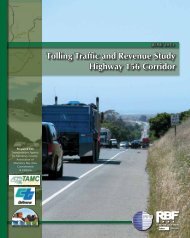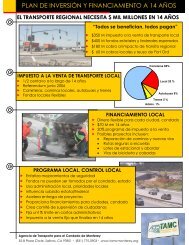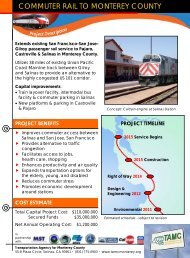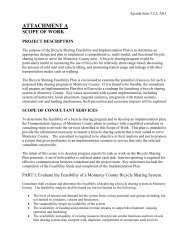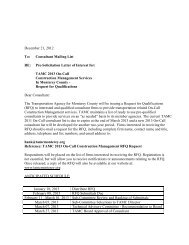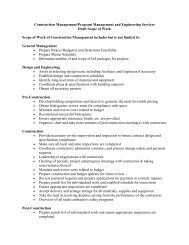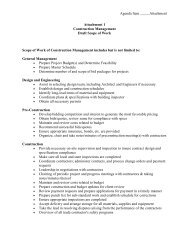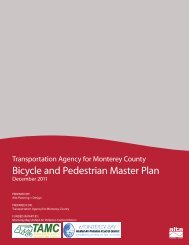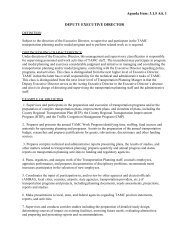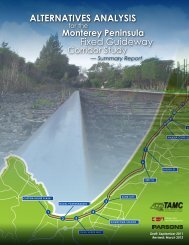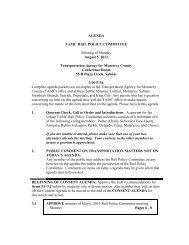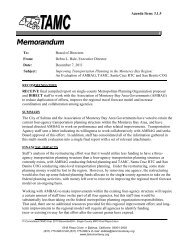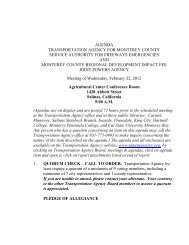Commuter Rail Extension Alternatives Analysis - Transportation ...
Commuter Rail Extension Alternatives Analysis - Transportation ...
Commuter Rail Extension Alternatives Analysis - Transportation ...
You also want an ePaper? Increase the reach of your titles
YUMPU automatically turns print PDFs into web optimized ePapers that Google loves.
CALTRAIN EXTENSION TO MONTEREY COUNTYALTERNATIVES ANALYSISBus Rapid Transit ServiceBus rapid transit (BRT) has been defined as a rapid mode of transportation that can provide thequality of rail transit and the flexibility of buses. It is an integrated system of stations, equipment,services, running ways, and intelligent transportation system (ITS) elements having a strong imageand identity.The Bus Rapid Transit Practitioner’s Guide 5 identifies the following components and features of busrapid transit systems.“The main features of bus rapid transit systems include:• Dedicated (bus-only) running ways (preferably physically separated from othertraffic)• Accessible, safe, secure, and attractive stations• Easy-to-board, attractive, and environmentally friendly vehicles• Efficient (i.e., off-vehicle) fare collection• ITS applications to provide real-time passenger information, signal priority, andservice command/control• Frequent, all-day service• Distinctive system identity“All BRT systems must have running ways, stations, and vehicles. Other major componentsinclude service design, the fare collection system, the application of ITS technology,and branding. Service design is the key to system design. The individual componentsmust be compatible and must support the service design.“The type of each component varies among systems. Running ways include special physicalfacilities such as busways, and operational treatments such as bus lanes, queuejumps/bypass lanes, and transit signal priority (TSP). Stations can range from smallerpassenger waiting areas with simple shelters to large-scale terminals with many passengeramenities. BRT vehicles typically are large-capacity, stylized vehicles with lowfloorboarding and different degrees of ITS integration, such as automatic vehicle location(AVL), next-stop annunciators, and driver-assist systems. Fare collection systemscan be located either on- or off-board vehicles and can integrate new electronic mediasuch as smart cards. Service design can range from BRT serving as a new line-haulservice with limited stops to BRT serving as a feeder service that extends the reach ofrail transit. Finally, branding the system creates a unique logo, color scheme, and/ormarketing strategy that distinguishes the BRT service from other transit services.”Compared to the Express Bus Alternative, a Bus Rapid Transit Alternative would add dedicated (busonly)running ways, or at least high occupancy vehicle (HOV) lanes, along US 101 from Salinas toMorgan Hill; use advanced design, articulated, low-floor vehicles; and operate throughout the daywith frequencies of service of 15 minutes or less. Given these features, a Bus Rapid TransitAlternative would not be comparable to the Caltrain <strong>Extension</strong> Alternative, and would be far moreexpensive to construct and operate.Adding HOV lanes to US 101 from Main Street in Salinas to Cochrane Road in Morgan Hill, adistance of 38.6 miles would cost on the order of $500 million including necessary bridge and5Draft Report, TCRP Project A-23A, Kittleson & Associates, 2006.parsons CHAPTER 3: DETAILED DEFINITION OF ALTERNATIVES 92



